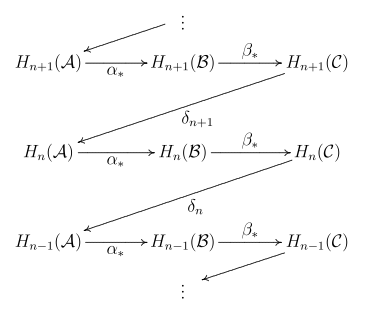数学、特にホモロジー代数学におけるジグザグ補題(ジグザグほだい、英: zig-zag lemma)は、鎖複体のホモロジー群から成るある種の長完全列の存在を述べるものである。この結果は任意のアーベル圏で通用する。
補題の主張
任意のアーベル圏(アーベル群の圏や与えられた体上のベクトル空間の圏など)において、 が以下の短完全列を満たす鎖複体だとする:
が以下の短完全列を満たす鎖複体だとする:

この系列は以下の可換図式の略記であるとする:

ここで各行は全て完全で、各列は全て鎖複体である。
ジグザグ補題は、境界写像(族)

が存在して、次の系列を完全にすることができることを主張する:

 と
と  は、通常のやり方で誘導されたホモロジー群の間の写像である。境界写像
は、通常のやり方で誘導されたホモロジー群の間の写像である。境界写像  は以下の節で説明する。この補題の名称は、系列における写像が「ジグザグ」に走ることから来ている。不運な用語法のバッティングにより、ホモロジー代数には『蛇の補題』の名を持つ別の結果があるにもかかわらず、この命題(ジグザグ補題)はその名(蛇の補題)でも一般に知られている。蛇の補題を使うと、ジグザグ補題のここに記すものとは別の証明が得られる。
は以下の節で説明する。この補題の名称は、系列における写像が「ジグザグ」に走ることから来ている。不運な用語法のバッティングにより、ホモロジー代数には『蛇の補題』の名を持つ別の結果があるにもかかわらず、この命題(ジグザグ補題)はその名(蛇の補題)でも一般に知られている。蛇の補題を使うと、ジグザグ補題のここに記すものとは別の証明が得られる。
境界写像の構成
写像  は標準的な図式追跡の議論を使って定義できる。
は標準的な図式追跡の議論を使って定義できる。 を、
を、  に属すある同値類の代表元とする。よって
に属すある同値類の代表元とする。よって  。行方向の完全性より
。行方向の完全性より  は全射なので、
は全射なので、 となる
となる  が存在しなければならない。図式の可換性より、
が存在しなければならない。図式の可換性より、

再び行方向の完全性より、

 は単射だから、
は単射だから、 を満たす
を満たす  が一意的に存在する。これは輪体である。なぜなら
が一意的に存在する。これは輪体である。なぜなら  は単射で、かつ
は単射で、かつ  より
より

が従うからである(つまり  )。
)。 は輪体なので、
は輪体なので、 に属すある同値類の代表元になる。ここで、
に属すある同値類の代表元になる。ここで、
![{\displaystyle \delta _{}^{}[c]=[a]}](https://wikimedia.org/api/rest_v1/media/math/render/svg/59e1f2259b95b17f0aedbe120073bd1bfa974133)
と定義する。このように定義された境界写像は well-defined であることが示せる(つまり写像が c と b の選択に依らずに定まる。証明は上記の図式追跡の議論と同様である)。また同様の議論で、長系列が各ホモロジー群のところで完全であることも示せる。
関連項目
参考文献
- Hatcher, Allen (2002). Algebraic Topology. Cambridge University Press. ISBN 0-521-79540-0. http://www.math.cornell.edu/~hatcher/AT/ATpage.html
- Lang, Serge (2002), Algebra, Graduate Texts in Mathematics, 211 (Revised third ed.), New York: Springer-Verlag, ISBN 978-0-387-95385-4, MR1878556, https://books.google.co.jp/books?id=Fge-BwqhqIYC
- Munkres, James R. (1993). Elements of Algebraic Topology. New York: Westview Press. ISBN 0-201-62728-0

























![{\displaystyle \delta _{}^{}[c]=[a]}](https://wikimedia.org/api/rest_v1/media/math/render/svg/59e1f2259b95b17f0aedbe120073bd1bfa974133)






